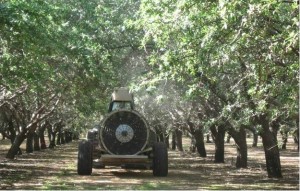 A replicated field trial in mature Non-pareil almonds at hull split using a diamide insecticide (Altacor®) measured better navel orange worm (NOW) control in the tops of pruned vs unpruned trees. As regulatory and/or resistance issues with key pests (navel orange worm, alternaria, etc.) move the almond industry towards selective pesticides that require excellent coverage to deliver effective pest control, growers may want to review pruning options for young and mature trees with an eye to improving spray coverage in the upper tree canopy.
A replicated field trial in mature Non-pareil almonds at hull split using a diamide insecticide (Altacor®) measured better navel orange worm (NOW) control in the tops of pruned vs unpruned trees. As regulatory and/or resistance issues with key pests (navel orange worm, alternaria, etc.) move the almond industry towards selective pesticides that require excellent coverage to deliver effective pest control, growers may want to review pruning options for young and mature trees with an eye to improving spray coverage in the upper tree canopy.
In the past 20 years, careful research and field experience has shown a lack of yield improvement in pruned vs. unpruned orchards. Many growers have opted to keep the $500+/acre cumulative cost of pruning and don’t prune after scaffold selection and clean up in the 1-2 leaf. The movement to less pruning has occurred almost simultaneously with increased planting density and nutrient and water inputs, producing dense, high yielding orchards.
At roughly the same time that almond orchard canopies have become denser, regulatory and resistance pressures have also changed the effective pesticide chemistries available for use in almond orchards. Selective insecticides (Altacor, Belt, Delegate, Intrepid, etc.) and all fungicides, including those high resistance risk materials with single-site activity (Tilt, Abound, etc.) require excellent coverage to deliver effective pest control. Broad spectrum insecticides such as pyrethroids (Brigade, Warrior, Asana, etc.) have been highly effective on NOW, but resistance or at least an increase in tolerance to these materials is beginning to appear in NOW populations in certain regions of the state. Resistance risk to single-site fungicides in fungal pest populations is increased by poor spray coverage. If alternative, selective pesticides are key options in the future almond pesticide arsenal, what does the movement towards non-pruning of mature trees mean for almond pest management now and in the future?
In July, 2012, a field experiment, led by Dr. Ken Giles from UC Davis, was conducted in a mature, highly productive Non-pareil/Carmel/Monterey/Sonora orchard at the Nickels Soil Lab near Arbuckle in Colusa County. This orchard was planted by John Edstrom, recently retired UC Farm Advisor in Colusa Co, in 1997 to test if no pruning after the first leaf reduced yield through the life of the orchard compared to conventionally pruned trees. At hull split, pruned and unpruned trees were sprayed with Altacor® (4 oz/acre) and 8 oz of non-ionic surfactant/acre using 100 gallons per acre spray volume and a tractor/sprayer ground speed of 2 MPH with a conventional PTO sprayer (see photo below). Sprayed nuts were sampled from the tops and bottoms of each tree at one and fourteen days after spraying and then immediately shipped to Dr. Joel Siegel’s lab at USDA Parlier. These nuts were placed in 5 gallon buckets with a set number of NOW eggs and left in an incubator. After six weeks, the number of live NOW larvae were counted. After a day, there was no difference in control between the pruned and unpruned trees either low or high in the canopy. There was 6% less control (better worm survival) in the nuts from the top vs. the lower canopy. After two weeks, differences in pest control between the pruning treatments could be measured in the nuts from the upper canopy, but not the lower canopy. NOW survival was 4% higher in the nuts from the tops of the unpruned trees compared to nuts from the tops of the pruned trees.
Spray movement from conventional (round end) airblast sprayer throughout dense almond canopies is limited, reducing spray coverage in tree tops. How much of a difference this makes on the future of almond production practices, including pruning practices, remains to be seen.

